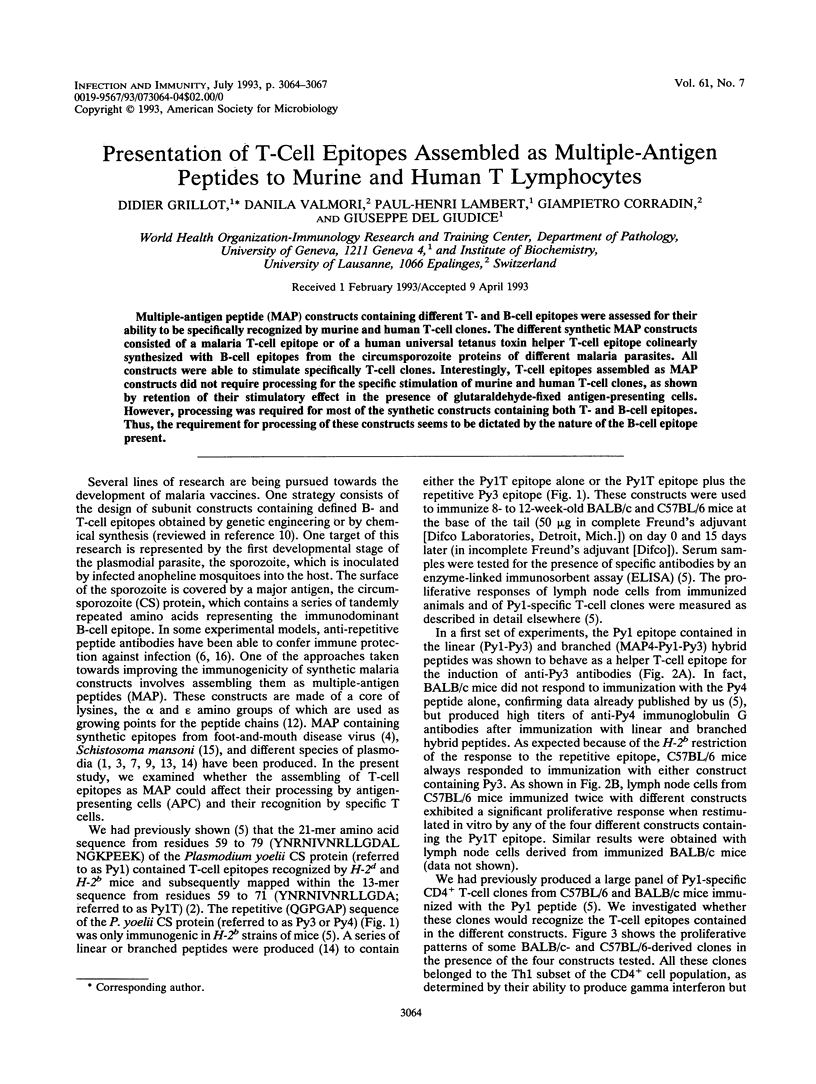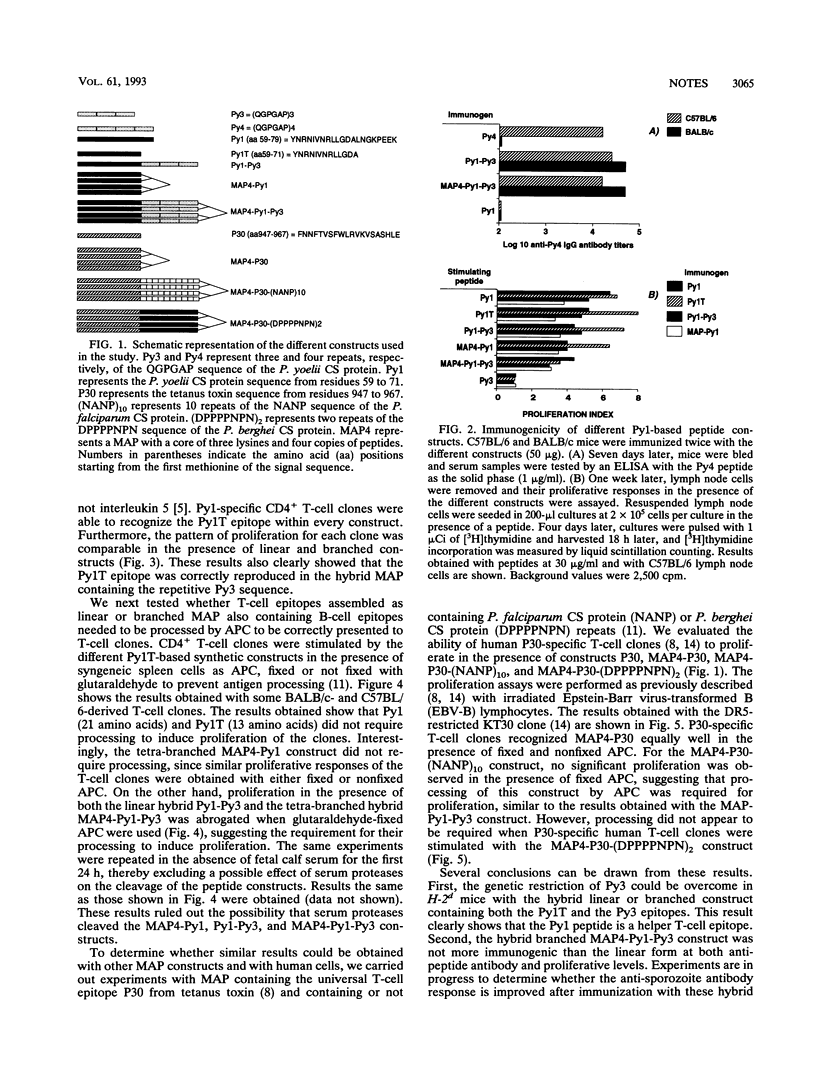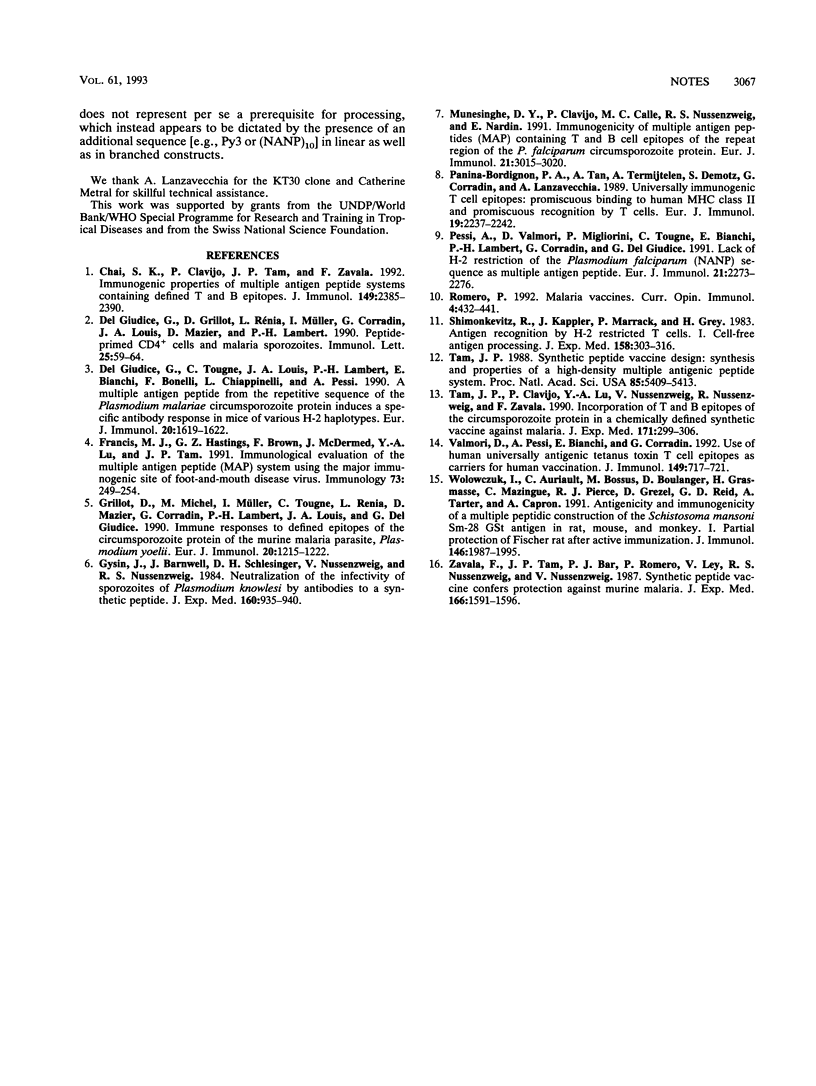Abstract
Multiple-antigen peptide (MAP) constructs containing different T- and B-cell epitopes were assessed for their ability to be specifically recognized by murine and human T-cell clones. The different synthetic MAP constructs consisted of a malaria T-cell epitope or of a human universal tetanus toxin helper T-cell epitope collinearly synthesized with B-cell epitopes from the circumsporozoite proteins of different malaria parasites. All constructs were able to stimulate specifically T-cell clones. Interestingly, T-cell epitopes assembled as MAP constructs did not require processing for the specific stimulation of murine and human T-cell clones, as shown by retention of their stimulatory effect in the presence of glutaraldehyde-fixed antigen-presenting cells. However, processing was required for most of the synthetic constructs containing both T- and B-cell epitopes. Thus, the requirement for processing of these constructs seems to be dictated by the nature of the B-cell epitope present.
Full text
PDF



Selected References
These references are in PubMed. This may not be the complete list of references from this article.
- Chai S. K., Clavijo P., Tam J. P., Zavala F. Immunogenic properties of multiple antigen peptide systems containing defined T and B epitopes. J Immunol. 1992 Oct 1;149(7):2385–2390. [PubMed] [Google Scholar]
- Del Giudice G., Grillot D., Rénia L., Müller I., Corradin G., Louis J. A., Mazier D., Lambert P. H. Peptide-primed CD4+ cells and malaria sporozoites. Immunol Lett. 1990 Aug;25(1-3):59–63. doi: 10.1016/0165-2478(90)90092-5. [DOI] [PubMed] [Google Scholar]
- Del Giudice G., Tougne C., Louis J. A., Lambert P. H., Bianchi E., Bonelli F., Chiappinelli L., Pessi A. A multiple antigen peptide from the repetitive sequence of the Plasmodium malariae circumsporozoite protein induces a specific antibody response in mice of various H-2 haplotypes. Eur J Immunol. 1990 Jul;20(7):1619–1622. doi: 10.1002/eji.1830200733. [DOI] [PubMed] [Google Scholar]
- Francis M. J., Hastings G. Z., Brown F., McDermed J., Lu Y. A., Tam J. P. Immunological evaluation of the multiple antigen peptide (MAP) system using the major immunogenic site of foot-and-mouth disease virus. Immunology. 1991 Jul;73(3):249–254. [PMC free article] [PubMed] [Google Scholar]
- Grillot D., Michel M., Müller I., Tougne C., Rènia L., Mazier D., Corradin G., Lambert P. H., Louis J. A., Del Guidice G. Immune responses to defined epitopes of the circumsporozoite protein of the murine malaria parasite, Plasmodium yoelii. Eur J Immunol. 1990 Jun;20(6):1215–1222. doi: 10.1002/eji.1830200604. [DOI] [PubMed] [Google Scholar]
- Gysin J., Barnwell J., Schlesinger D. H., Nussenzweig V., Nussenzweig R. S. Neutralization of the infectivity of sporozoites of Plasmodium knowlesi by antibodies to a synthetic peptide. J Exp Med. 1984 Sep 1;160(3):935–940. doi: 10.1084/jem.160.3.935. [DOI] [PMC free article] [PubMed] [Google Scholar]
- Munesinghe D. Y., Clavijo P., Calle M. C., Nussenzweig R. S., Nardin E. Immunogenicity of multiple antigen peptides (MAP) containing T and B cell epitopes of the repeat region of the P. falciparum circumsporozoite protein. Eur J Immunol. 1991 Dec;21(12):3015–3020. doi: 10.1002/eji.1830211217. [DOI] [PubMed] [Google Scholar]
- Panina-Bordignon P., Tan A., Termijtelen A., Demotz S., Corradin G., Lanzavecchia A. Universally immunogenic T cell epitopes: promiscuous binding to human MHC class II and promiscuous recognition by T cells. Eur J Immunol. 1989 Dec;19(12):2237–2242. doi: 10.1002/eji.1830191209. [DOI] [PubMed] [Google Scholar]
- Pessi A., Valmori D., Migliorini P., Tougne C., Bianchi E., Lambert P. H., Corradin G., Del Giudice G. Lack of H-2 restriction of the Plasmodium falciparum (NANP) sequence as multiple antigen peptide. Eur J Immunol. 1991 Sep;21(9):2273–2276. doi: 10.1002/eji.1830210941. [DOI] [PubMed] [Google Scholar]
- Romero P. Malaria vaccines. Curr Opin Immunol. 1992 Aug;4(4):432–441. doi: 10.1016/s0952-7915(06)80035-x. [DOI] [PubMed] [Google Scholar]
- Shimonkevitz R., Kappler J., Marrack P., Grey H. Antigen recognition by H-2-restricted T cells. I. Cell-free antigen processing. J Exp Med. 1983 Aug 1;158(2):303–316. doi: 10.1084/jem.158.2.303. [DOI] [PMC free article] [PubMed] [Google Scholar]
- Tam J. P., Clavijo P., Lu Y. A., Nussenzweig V., Nussenzweig R., Zavala F. Incorporation of T and B epitopes of the circumsporozoite protein in a chemically defined synthetic vaccine against malaria. J Exp Med. 1990 Jan 1;171(1):299–306. doi: 10.1084/jem.171.1.299. [DOI] [PMC free article] [PubMed] [Google Scholar]
- Tam J. P. Synthetic peptide vaccine design: synthesis and properties of a high-density multiple antigenic peptide system. Proc Natl Acad Sci U S A. 1988 Aug;85(15):5409–5413. doi: 10.1073/pnas.85.15.5409. [DOI] [PMC free article] [PubMed] [Google Scholar]
- Valmori D., Pessi A., Bianchi E., Corradin G. Use of human universally antigenic tetanus toxin T cell epitopes as carriers for human vaccination. J Immunol. 1992 Jul 15;149(2):717–721. [PubMed] [Google Scholar]
- Wolowczuk I., Auriault C., Bossus M., Boulanger D., Gras-Masse H., Mazingue C., Pierce R. J., Grezel D., Reid G. D., Tartar A. Antigenicity and immunogenicity of a multiple peptidic construction of the Schistosoma mansoni Sm-28 GST antigen in rat, mouse, and monkey. 1. Partial protection of Fischer rat after active immunization. J Immunol. 1991 Mar 15;146(6):1987–1995. [PubMed] [Google Scholar]
- Zavala F., Tam J. P., Barr P. J., Romero P. J., Ley V., Nussenzweig R. S., Nussenzweig V. Synthetic peptide vaccine confers protection against murine malaria. J Exp Med. 1987 Nov 1;166(5):1591–1596. doi: 10.1084/jem.166.5.1591. [DOI] [PMC free article] [PubMed] [Google Scholar]


